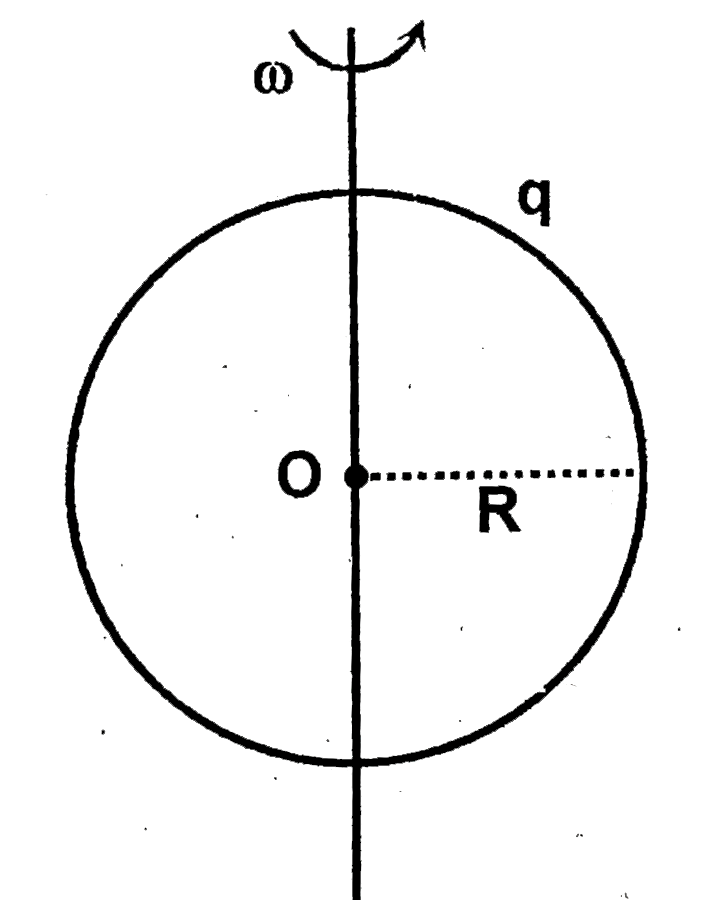A small body of mass m=0.30kg starts sliding down from the top of a smooth sphere of radius R=1.00m. The sphere rotates with a constant angular velocity ω=6.0rad/s about a vertical axis passing through its centre. Find the centrifugal force of inertia and the Coriolis force at the moment when the body breaks off the surface of the sphere in the reference frame fixed to the sphere.
The equation of motion in the rotating coordinate system is,
m→w=→F+mω2→R+2m(→v×→ω)
Now, →v=Rθ→e0+Rsinθ.φ→eφ
and →w=w′cosθ→er−w′sinθ→e0
12m→Fcor=∣∣
∣
∣∣→er+→e0→eφ0RθRsinθ.φωcosθ−ωsinθ0∣∣
∣
∣∣
=→er(ωRsin2θ.φ)+ωRsinθcosθ.φ→eθ−ωRcosθ→eθ
Now on the sphere,
→v=(−R.θ2−Rsin2θφ2)→er
+(R.θ−Rsinθcosθ.φ2)→eθ
+(Rsinθ..φ+2Rcosθ.θ.φ)→evaprhi
Thus the equation of motion are,
m(−R.θ2−Rsin2θ.φ2)=N−mgcosθ+mω2Rsin2θ+2mωRsin2θ.φ
m(R.θ−Rsinθcosθ.φ2)=mgsinθ+mω2Rsinθcosθ+2mωRsinθcosθ.φ
m(Rsinθ..φ+2Rcosθ.θ.φ)=−2mωrR.θcosθ
From the third equation, we get, φ.=−ω
A result that is easy to understand by considering the motion in non-rotating frame. The eliminating .φ we get,
mRθ.2=mgcosθ−N
mRθ.=mgsinθ
Integrating the last equation,
12mRθ.2=mg(1−cosθ)
Hence N=(3−2cosθ)mg
So the body must fly off for θ=θ0=cos−123, exactly as if the sphere were nonrotating.
Now, at this point Fef= centrifugal force =mω2Rsinθ0=√59mω2R
Fcor=√ω2R2θ2cos2θ+(ω2R2)2sin2θ×2m
=√59(ω2R)2+ω2R2×49×2g3R×2m=23mω2R√5+8g3ω2R

Topper's Solved these Questions
- PHYSICAL FUNDAMENTALS OF MECHANICSBook:IE IRODOV, LA SENA & SS KROTOVChapter:PHYSICAL FUNDAMENTALS OF MECHANICSExercise:Laws Of Conservation Of Energy, Momentum And Angular Momentum
Explore 82 Videos
- PHYSICAL FUNDAMENTALS OF MECHANICSBook:IE IRODOV, LA SENA & SS KROTOVChapter:PHYSICAL FUNDAMENTALS OF MECHANICSExercise:Universal Gravitation
Explore 34 Videos
- PHYSICAL FUNDAMENTALS OF MECHANICSBook:IE IRODOV, LA SENA & SS KROTOVChapter:PHYSICAL FUNDAMENTALS OF MECHANICSExercise:Relativistic Mechanics
Explore 49 Videos
- OSCILLATIONS AND WAVESBook:IE IRODOV, LA SENA & SS KROTOVChapter:OSCILLATIONS AND WAVESExercise:Electromagnetic Waves, Radiation
Explore 36 Videos
- THERMODYNAMICS AND MOLECULAR PHYSICSBook:IE IRODOV, LA SENA & SS KROTOVChapter:THERMODYNAMICS AND MOLECULAR PHYSICSExercise:Transport Phenomena
Explore 38 Videos
Similar Questions
A non-conducting sphere of radius R=50mm charged uniformly with surface density σ=10.0μC/m2 rotates with an angular velocity ω=70 rad/s about the asxis passign thorugh its centre. Find the magnetic induction at the centre of the sphere.
View SolutionA horizontal smooth rod AB rotates with a constant angular velocity ω=2.00rad/s about a vertical axis passing through its end A. A freely sliding sleeve of mass m=0.50g moves along the rod from the point A with the initial velocity v0=1.00m/s. Find the Coriolis force acting on the sleeve (in the reference frame fixed to rotating rod) at the moment when the sleeve is located at the distance r=50cm from the rotation axis.
View Solution
Knowledge Check
A rigid body of mass m rotates about an axis passing through its centre. If the angular velocity of the body is unity, the moment of inertia of the body will be equal to
Akinetic energy of the bodyBtwice the kinetic energy of the bodyCangular momentum of the bodyDtwice the angular momentum of the bodyA rigid body of mass m rotates about an axis passing through its centre. If the angular velocity of the body is unity, the moment of inertia of the body will be equal to
Akinetic energy of the bodyBtwice the kinetic energy of the bodyCangular momentum of the bodyDtwice the angular momentum of the bodyA particle of mass m starts to slide down from the top of the fixed smooth sphere. What is the tangential acceleration when it break off the sphere ?
A2g3B√5g3CgDg3
A particle of mass m starts to slide down from the top of the fixed smooth sphere. What is the tangential acceleration when it break off the sphere ?
View SolutionA hollow non conducting sphere of radius R has a positive charge q uniformly distributed on its surface. The sphere starts rotating with a constant angular velocity 'ω' about an axis passing through center of sphere, as shown in the figure. Then the net magnetic field at center of the sphere is

View SolutionA small body A starts sliding off the top of a smooth sphere of radius R. Find the angle θ (figure) corresponding to the point at which the body breaks off the sphere, as well as the break-off velocity of the body.

View SolutionA small body is placed on the top of a smooth sphere of radius R. Then the sphere is imparted a constant acceleration w0 in the horizontal direction and the body begins sliding down. Find:
(a) the velocity of the body relative to the sphere at the moment of break-off,
(b) the angle θ0 between the vertical and the radius vector drawn from the centre of the sphere to the break-off point, calculate θ0 for w0=g.
View SolutionA hollow non conducting sphere of radius R has a positive charge q uniformly distributed on its surface. The sphere starts rotating with a constant angular velocity 'ω' about an axis passing through center of sphere, as shown in the figure. Then the net magnetic field at center of the sphere is

View Solution

